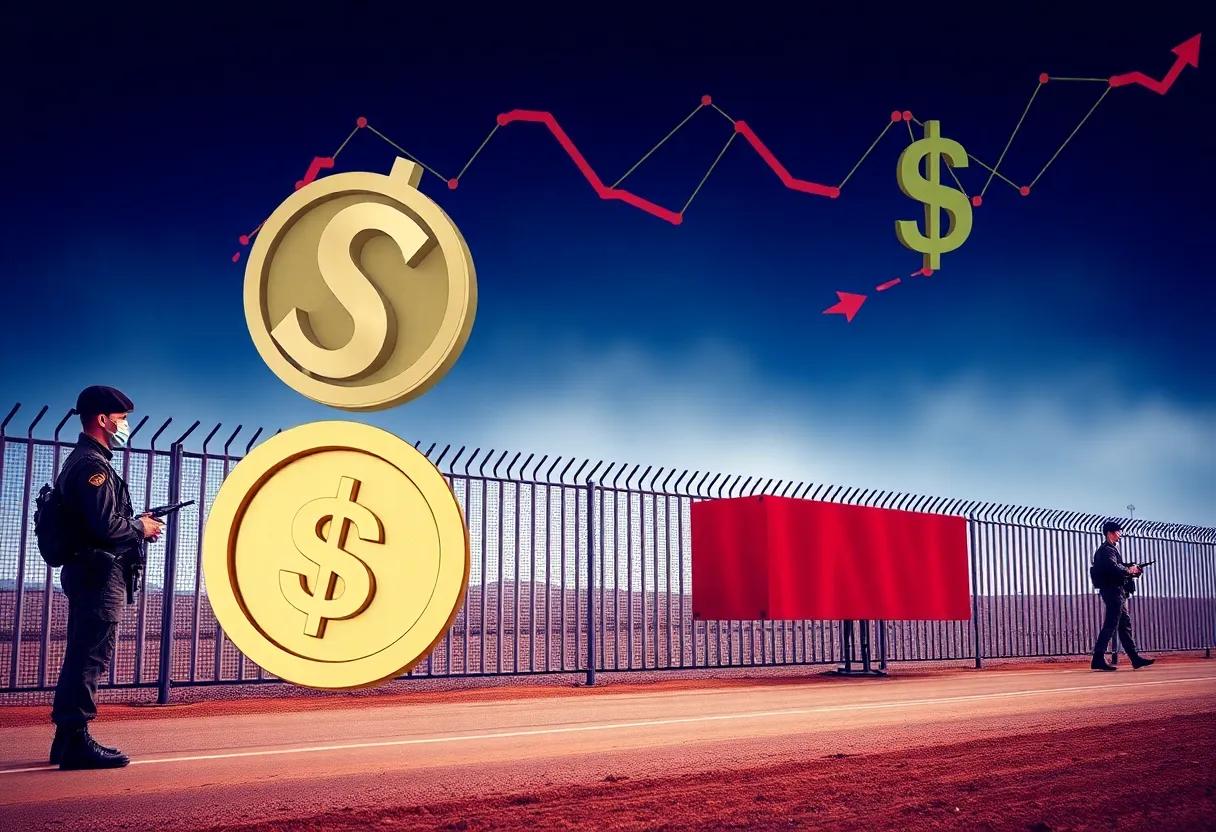News Summary
US President Donald Trump and Mexico’s President Claudia Sheinbaum have reached a deal to postpone tariffs for one month amid trade tensions. Mexico will send 10,000 soldiers to the border as part of this agreement. The market response has been volatile, with the Dow Jones Industrial Average experiencing sharp declines, while cryptocurrencies like Bitcoin rose. This tariff delay comes as companies brace for significant financial impacts from future tariffs on Canadian and Chinese imports, raising concerns over consumer prices and corporate earnings amidst fears of a broader trade war.
Big Changes as Trump and Mexico Push Back Tariffs for One Month
In a surprising turn of events, US President Donald Trump and Mexico’s President Claudia Sheinbaum have announced a deal to delay tariffs for one month. This pact comes amid heightened tensions and concerns over trade practices between the neighboring countries. To seal the deal, Mexico has agreed to deploy 10,000 soldiers to the border, a move intended to bolster security and ease the strain between the nations.
Market Reaction: A Rollercoaster of Ups and Downs
As news of this tariff delay broke, the stock market reacted swiftly. Right at the opening, the Dow Jones Industrial Average plummeted, losing around 600 points. By the end of the trading day, the Dow managed to close down by approximately 122 points, which is a 0.27% decline. The S&P 500 dipped by 0.76%, while the Nasdaq Composite saw a more significant drop of 1.2%.
Interestingly, amid the tumult, cryptocurrencies such as Bitcoin saw a mid-morning rebound, proving that not all markets are reacting the same way. While the auto sector faced turmoil, with companies like GM falling over 3%, they rebounded from earlier losses exceeding 7%. The unpredictable zigzags of the market left investors on edge.
A Broader Financial Picture: Currency and Energy Prices Surge
The shift in tariffs hasn’t just impacted stocks; the US dollar also experienced a notable rise amid concerns surrounding tariffs. On the energy front, costs surged due to Canadian tariffs that are still set to go into effect. Tariffs on Canadian electricity, natural gas, and oil exports to the US are now lowered to 10%, which still leaves room for price concerns, especially as economic analysis predicts possible inflation due to these tariffs.
What’s in Store for Tariffs?
Taking a step back to the larger picture, a 25% tariff on most Canadian imports is due to kick in soon, along with a 10% tariff on Chinese goods. This new set of tariffs marks a considerable escalation compared to previous measures and is expected to add around $830 in costs for the average American household by 2025.
Corporate America is bracing for impact as reactions from businesses lean heavily negative. Experts predict a staggering $700 million tax burden daily on US companies due to these tariffs. The agriculture sector, in particular, has been vocal in urging for subsidies in light of potential retaliatory tariffs that could affect them seriously.
The Financial Outlook: What Analysts are Saying
In the evaluation of the overall impact, Goldman Sachs suggests that while the tariffs may be short-lived, they pose significant risks to corporate earnings. This uncertainty has already been palpable in stock market volatility, illustrated by significant shifts in the VIX, a measure of market fluctuations, which pulled back after the announcement.
Additionally, speculation is swirling around future tariffs on European Union goods, leaving many wondering what the next steps in trade negotiations will entail. Analysts are expressing concern that unresolved trade issues could escalate into a broader trade war, further complicating the financial landscape.
Final Thoughts: The Road Ahead
The Dow Jones Industrial Average and S&P 500 indices showed slight signs of recovery despite closing lower than previous levels following Trump’s surprise announcement. Investors are likely keeping a close watch to see how long this tariff delay will last and its overall impact on both the stock market and consumer prices going forward. With a hint of uncertainty in the air, it’s clear that we are in for more twists and turns in this unfolding financial saga.
Deeper Dive: News & Info About This Topic
- Bloomberg
- The New York Times
- CNBC
- Forbes
- Associated Press
- Wikipedia: Tariffs
- Google Search: Trump tariffs
- Google Scholar: Impact of tariffs
- Encyclopedia Britannica: Trade tariffs
- Google News: Trump tariffs impact

Author: STAFF HERE CHARLESTON
The CHARLESTON STAFF WRITER represents the experienced team at HEREcharleston.com, your go-to source for actionable local news and information in Charleston, Charleston County, and beyond. Specializing in "news you can use," we cover essential topics like product reviews for personal and business needs, local business directories, politics, real estate trends, neighborhood insights, and state news affecting the area—with deep expertise drawn from years of dedicated reporting and strong community input, including local press releases and business updates. We deliver top reporting on high-value events such as the Spoleto Festival USA, Charleston Wine + Food Festival, and the MOJA Festival. Our coverage extends to key organizations like the Charleston Metro Chamber of Commerce and the Charleston Museum, plus leading businesses in tourism and maritime industries that power the local economy such as South Carolina Ports Authority and the Charleston Visitor Center. As part of the broader HERE network, including HEREaiken.com, HEREbeaufort.com, HEREchapin.com, HEREcharleston.com, HEREclinton.com, HEREcolumbia.com, HEREgeorgetown.com, HEREgreenwood.com, HEREgreenville.com, HEREhiltonhead.com, HEREirmo.com, HEREmyrtlebeach.com, HEREnewberry.com, HERErockhill.com, HEREspartanburg.com, HEREaustin.com, HEREcollegestation.com, HEREdallas.com, HEREhouston.com, and HEREsanantonio.com, we provide comprehensive, credible insights into South Carolina's dynamic landscape.





